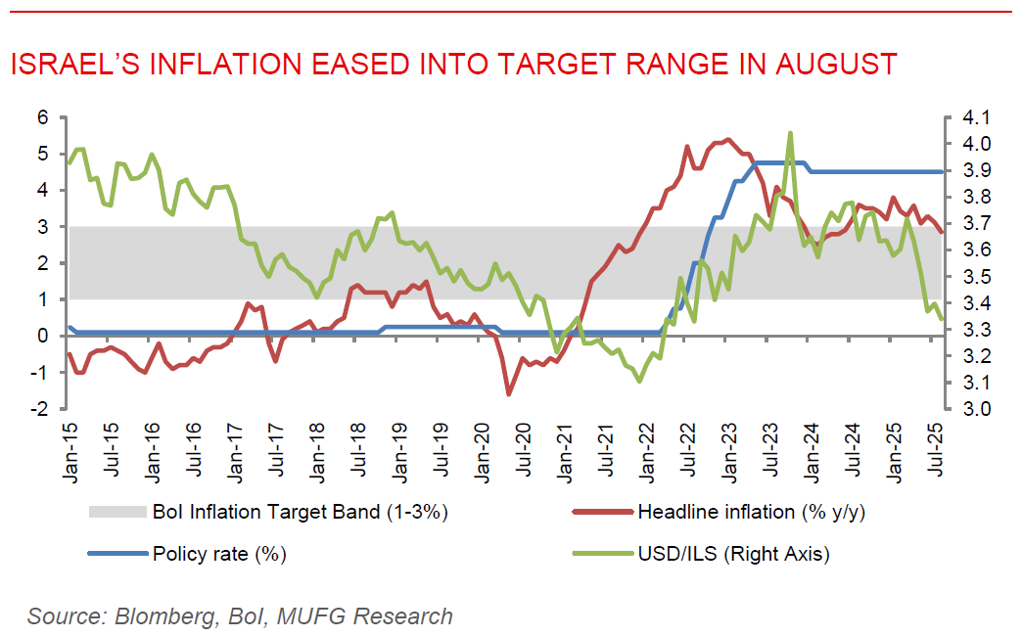To read the full report, please download the PDF above.
Middle East Daily
SOOJIN KIM
Research Analyst
DIFC Branch – Dubai
T: +44(4)387 5031
E: soojin.kim@ae.mufg.jp
MUFG Bank, Ltd. and MUFG Securities plc
A member of MUFG, a global financial group
Middle East Daily
COMMODITIES / ENERGY
Oil holds steady amid sanctions talk and surplus fears. Oil prices held steady above USD67/b for Brent and around USD63/b for WTI after a couple of gain-days, as markets weighted the tension between potential new Western sanctions on Russian oil flows and growing evidence of oversupply. The European Union is reportedly considering sanctions targeting companies in India and China that facilitate Russia’s crude trade, potentially as part of an upcoming sanctions package. Meanwhile, India is stepping up enforcement. Adani Group has banned sanction-listed vessels from its 14 ports, causing reroutes of tankers carrying Russian crude. These developments coincide with the International Energy Agency forecasting a record surplus next year, driven in part by OPEC+ bringing back more previously curtailed output. On the demand side, expectations are for a US Fed rate cut soon, which might support energy demand, though recent tightening of policy elsewhere partly offsets that.
Gold surges to another record high on Fed rate-cut bets. Gold pushed to a fresh all-time high above USD3,685/oz today, fuelled by investor expectations that the Fed will cut rates this week and potentially signal more easing ahead. The rally was reinforced by a weaker dollar and growing conviction that subdued labour data and contained inflation will allow policymakers to loosen monetary conditions further. Mounting political pressure on the Fed, including President Trump’s attempt to remove Governor Lisa Cook and the anticipated appointment of Stephen Miran, has strengthened bets on a more dovish stance. Beyond US dynamics, strong central bank buying, steady ETF inflows, and global trade and geopolitical uncertainties have underpinned gold’s nearly 40% rally this year.
MIDDLE EAST - CREDIT TRADING
End of day comment – 15 September 2025. The market remains firm overall. Whilst some spreads might be wider today on the UST move, the 5-8bp tightening on Friday held. Or put otherwise, UST are roughly were they were Friday morning and cash 0.5pt/1pt higher depending where you look. The spread moves in between is just noise. In higher beta credits MOROC continued to squeeze with no offer side liquidity, 42s and 50s closed +0.75pt/-2bp. On the IG side QATAR was again on the quiet side activity wise but tracked broadly UST moves, 49s closing +0.5pt/unch. In the quasi sovereign space MUBAUH remains the strongest credit, seen buyers across bonds but given the granularity of the curve and small issue sizes, I have not seen many prints. Bonds closed 0.25/0.625pt higher and about 1/2bp tighter. Against this ADQABU and ADNOCM seeing some selling in 5-10y bonds, today mostly in ADQABU 30s closing -0.125pt/+5bp. In financials new DHBKQD 31s continues to trade heavy and had sellers throughout the day. Bonds traded at 99.10/T+110bp from 99.418/T+105bp at issuance. On the new issue side EIB announced a long 5y SLB Regs Sukuk which should price in the next couple of days. Away from this though the sovereign and quasi sovereign space ex KSA has yet to tap the market.
MIDDLE EAST - MACRO / MARKETS
Saudi inflation rose to 2.3% in August. Saudi Arabia’s inflation accelerated to 2.3% y/y in August 2025, up from 2.1% y/y in July, with prices rising 0.2% m/m, according to GASTAT’s newly revised CPI methodology. The increase was largely by higher housing-related costs, with the “housing, water, electricity, gas and other fuels” category rising 5.8%, led by a 7.6% jump in residential rents. Food and beverages climbed 1.1%, restaurants and hotel by about 3%, and personal care and related services by nearly 4.8%, while furnishing and communication costs eased slightly, offsetting part of the pressure. The August release marks the first under an updated base year (2023) and reweighted consumer basket, designed to better reflect evolving spending patterns and provide a more accurate view of cost of living trends. Going forward, inflationary pressures are likely to remain concentrated in housing and services, though contained food prices and subdued global energy trends may help anchor headline inflation within a relatively moderate range.
Israel’s inflation eased into target range in August. Israel’s CPI fell to 2.9% y/y in August from 3.1% y/y in July, marking the first time in over a year that inflation has fallen within the government’s 1-3% target range. The moderation reflects declines in categories such as fresh fruit, clothing, and furniture, though pressures persisted in foreign travel, entertainment, transportation, and fresh vegetables, alongside continued increases in housing-related costs. The return of annual inflation to target provides some relief after a prolonged period of elevated price growth and could give the Bank of Israel (BoI) more room to adjust its monetary stance in the months ahead. Going forward, an interest rate cut is unlikely in the near term, and policymakers are likely to remain cautious given underlying price pressures in housing and services.

